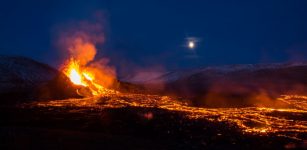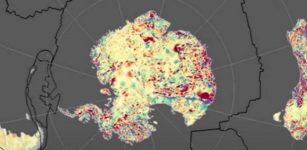Strange Ancient Underwater Yellow Brick Road Discovered Of The Hawaiian Islands
Jan Bartek – MessageToEagle.com – While conducting a survey of a deep-sea ridge just north of the Hawaiian Islands, the E/V Nautilus expedition suddenly spotted an incredibly unique and fascinating formation that looks like an ancient underwater yellow brick road.
Scientists captured footage of the Liliʻuokalani Ridge in the Pacific Ocean’s Papahānaumokuakea Marine National Monument, and many people wonder whether this unique formation is natural or artificial in nature.
A deep-sea ‘yellow brick road’. Credit: The Ocean Exploration Trust/E/V/Nautilus
It may look similar to the yellow brick road in The Wizard of Oz, or perhaps a hidden path to the mythical lost city of Atlantis.
It’s the road to Atlantis,’ a researcher on the radio can be heard saying.
“The yellow brick road?” another adds, while a separate member team member calls it ‘bizarre’ and ‘crazy’.
The team said: ‘” What may look like a “yellow brick road” to the mythical city of Atlantis is really an example of ancient active volcanic geology!”
“Is Atlantis real? Has it ever been found? Where is Atlantis? As there are no definite answers to these questions, Atlantis is still known as a fictional island mentioned in an allegory on the hubris of nations in Plato’s works Timaeus and Critias,” a report from Times Now News reads.
But scientists think they know what may have caused this natural phenomenon to form.
“Finding Atlantis may still be a dream, but we can tell you for sure that a group of marine scientists has discovered a strange yellow brick path at the bottom of the Pacific Ocean,” the story continues. Needless to say, it’s a fascinating find.
Although we truly wish this “yellow brick road” was built by a handy crew of marine munchkins, that sadly isn’t the case. In fact, it wasn’t even manmade.
The deep-sea researchers who spotted the incredible rock formation say it is actually an example of ancient active volcanic geology on the ocean floor near Hawaii.
The crew basically describes it as an example of ancient active volcanic geography. It is the result of many eruptions, over the course of centuries.
“Our Corps of Exploration have witnessed incredibly unique and fascinating geological formations while diving on the Liliʻuokalani Ridge within Papahānaumokuakea Marine National Monument.”
“At the summit of Nootka Seamount, the team spotted a “dried lake bed” formation, now IDed as a fractured flow of hyaloclastite rock (a volcanic rock formed in high-energy eruptions where many rock fragments settle to the seabed).
The unique 90-degree fractures are likely related to heating and cooling stress from multiple eruptions at this baked margin.
Throughout the seamount chain, the team also sampled basalts coated with ferromanganese (iron-manganese) crusts from across different depths and oxygen saturations as well as an interesting-looking pumice rock that almost resembled a sponge,” the Nautilus team added in a statement.
Along with the “yellow brick road,” the Exploration Vessel Nautilus team has also witnessed unique octopuses and other undersea creatures, showing what really happens deep beneath the waves.
The team said the primary objective of their latest expedition was to gather samples to determine the geologic origin and age of seamounts to gain a better understanding of the formation of the northwestern Hawaiian Islands.
Credit: The Ocean Exploration Trust/E/V/Nautilus
They added that the seamounts would also be surveyed for biodiversity, in the hope of finding rich coral and sponge communities commonly found at these depths.
‘Considering the presumed Cretaceous age of the Liliʻuokalani Ridge seamounts, it is expected that relatively thick ferromanganese crusts have formed on exposed rock surfaces, particularly on the flanks of the seamounts where sedimentation is minimized,’ they added.
An E/V Nautilus spokesperson said: ‘Our exploration of this never-before-surveyed area is helping researchers take a deeper look at life on and within the rocky slopes of these deep, ancient seamounts.
‘These studies will help provide baseline information on the living communities of seamounts which can inform management and conservation measures,” the science team said.
Written by Jan Bartek – MessageToEagle.com – AncientPages.com Staff Writer












